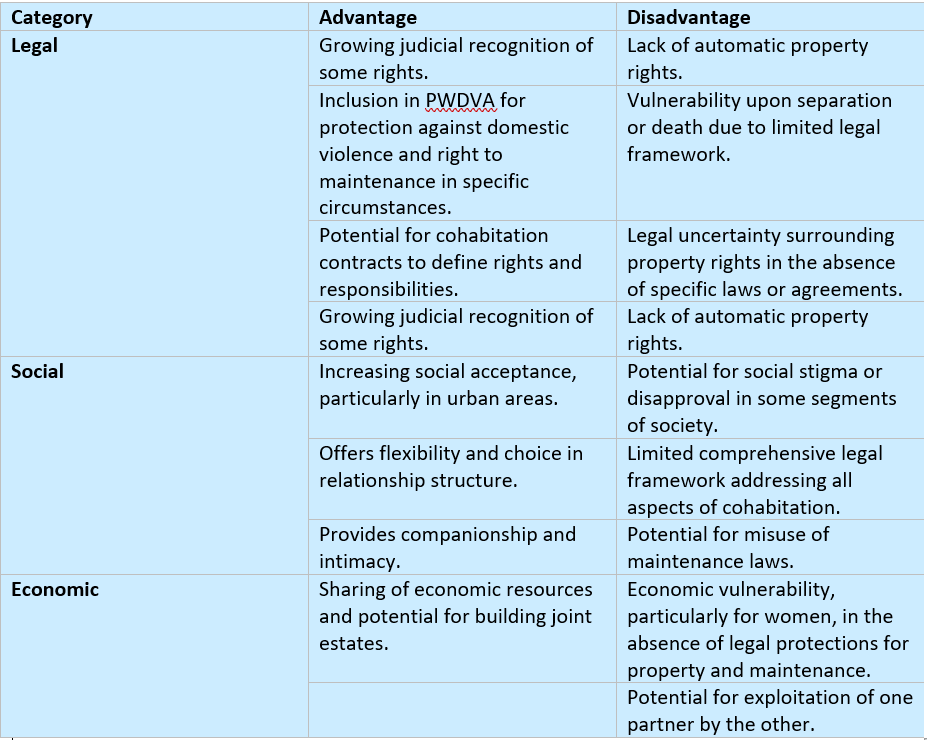
A Quick Look at Cohabitation in India
Living together or a live-in relationship, basically being in a close and steady relationship without tying the knot, is getting more attention in India these days. With these setups becoming more common, there is a need to dig into what they mean for the people involved and how they fit into the bigger picture of society. In an earlier essay we had shown how live-in relationships are not a new phenomenon. This essay takes a look into whether living together works for people in India, using up-to-date research.
Legal Recognition and Changing Rights for Couples Who Live Together
The legal scene for couples living together in India has been slowly shifting towards more recognition. But let us be clear, it is still a bit of a patchy road, with no clear-cut set of laws in place. One key case highlighted by Srivastava and Sakkarnaikar (2023) is Indra Sarma v VKV Sarma, where the Supreme Court honed in on two main rights for such couples: maintenance and property. Srivastava and Sakkarnaikar have been vocal about the need to acknowledge and protect unmarried cohabitation within the constitution, giving special attention to women’s economic rights. Women in live-in relationships could be left in tricky situations due to old-school gender roles, which might make them financially reliant on their partner.
Experts have suggested tweaking existing laws to make maintenance rights accessible to people in these relationships. For example, Srivastava and Sakkarnaikar mentions that Section 125 of the Code of Criminal Procedure should be revised to openly include unmarried cohabiting couples. Right now, things are a bit murky and rely too much on courts interpreting phrases like “in the nature of marriage.” A straightforward legal adjustment could make everything clearer and more consistent when it comes to providing maintenance.
Property Rights for Couples Without a Marriage Certificate
One tricky part of living together in India is figuring out property rights for people in such relationships. There is no specific law about how to handle property matters for couples who live together, and this leaves room for disputes, especially when things end or if one partner passes away. The partner with fewer assets could end up with financial issues.
Indian inheritance laws also acknowledge only married spouses. This leaves unmarried cohabitants in a tough spot, especially if they have chipped in financially towards shared assets. So, some experts suggest that cohabiting partners draw up agreements laying out who owns what and what happens to shared assets. These agreements could even cover things like supporting each other or plans for any kids.
Another way to sort property issues is the idea of constructive trusts, where courts recognise contributions, financial or not, by one partner, like household duties or caregiving. This offers a fairer way to divide up assets, especially when traditional roles come into play.
That said, giving property rights to cohabiting couples could weaken the idea of marriage. But researchers argue that live-in relationships are a growing reality and need some form of legal safety net, especially for partners with fewer economic resources. They also point to the low divorce rates in India to suggest that having cohabitation agreements is not likely to harm the institution of marriage too much.
Supporting Women in Live-In Relationships
Much of the discussion about living together in India focuses on financial support for women in such relationships. Women in cohabitation face the same financial dependence as those in marriages, especially if the relationship ends. This can happen due to career compromises or uneven earning power in the relationship. It is clear that legal measures to offer financial security to women in these scenarios are needed.
The courts in India have been interpreting existing laws more broadly to cater to women in cohabiting relationships. Laws like Section 125 of the Code of Criminal Procedure and the Protection of Women from Domestic Violence Act (PWDVA), 2005, have been extended to cover women in live-in relationships, allowing them to claim maintenance. This shows that the judiciary is recognising that women’s financial vulnerabilities in relationships are not exclusive to married couples.
Shifting Social Views on Living Together
To figure out if cohabitation is a good fit for India, it is worth looking at how people view it socially. In the past, Indian society mostly saw marriage as the only acceptable way for couples to be together, and living together without being married was frowned upon. But times are changing, even if old traditions do not shift overnight.
Surveys indicate that more people in India are warming up to the idea of live-in relationships as an acceptable way of life. Urban areas, with their mix of cultures and looser ties to traditional norms, are especially seeing a rise in this. Education, economic status, social media exposure, and age are all factors shaping how people feel about it.
Pros and Cons of Living Together in India
There are quite a few perks to living together. One big draw is the freedom it offers. People can share their lives and form bonds without the full-on commitments of marriage. These setups can provide emotional support, companionship, and even financial benefits like pooled resources.
But there are also pitfalls. The lack of automatic property rights, as mentioned earlier, leaves cohabiting partners vulnerable in certain situations. This legal uncertainty can lead to financial instability or even exploitation in some cases.

Conclusion: Is Living Together Right for You in India?
Living together in India comes with its ups and downs. On the bright side, there is the freedom to shape your relationship without the formalities of marriage, plus the emotional connection that shared living brings. On the flip side, there is the challenge of legal grey areas and the risk of one partner, particularly women, being more vulnerable.
Deciding whether to live together is a personal choice that boils down to your own values, beliefs, support systems, and unique situation. If you are thinking about this kind of arrangement, it is essential to understand the legal gaps and risks involved, especially when it comes to things like property and inheritance. In the current setup, drafting cohabitation agreements could be a smart move. These agreements can spell out who gets what and how money matters or other aspects of the relationship are handled, helping to protect both partners.
The growing academic interest in cohabitation in India shows how important it is becoming as a modern relationship choice. It also shines a light on the need for legal and social changes to make sure that people who choose this way of life are treated fairly and protected properly.
Download the Rematch app for more such relationship news and tips and to find long-term relationship matches.
References
Srivastava, Shreya, and Fakkiresh Sakkarnaikar (2023). “Cohabitation Contracts and Constructive Trusts, Tools to Secure Property Rights in Unmarried Cohabitation in India: An Analysis.” Lex Humana 15, no. 3.

